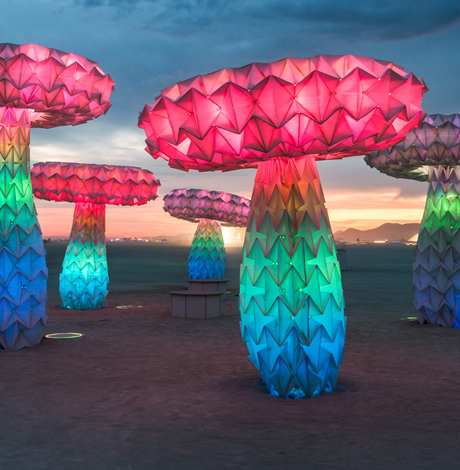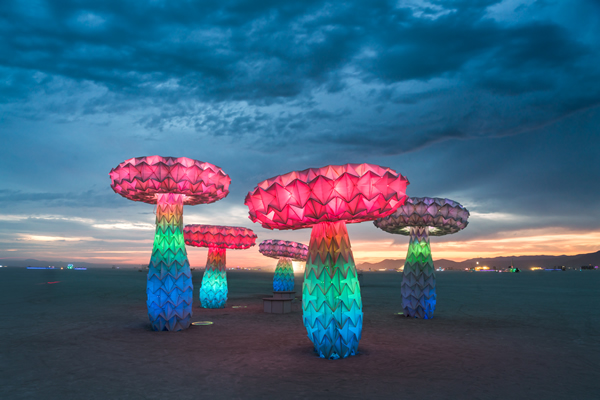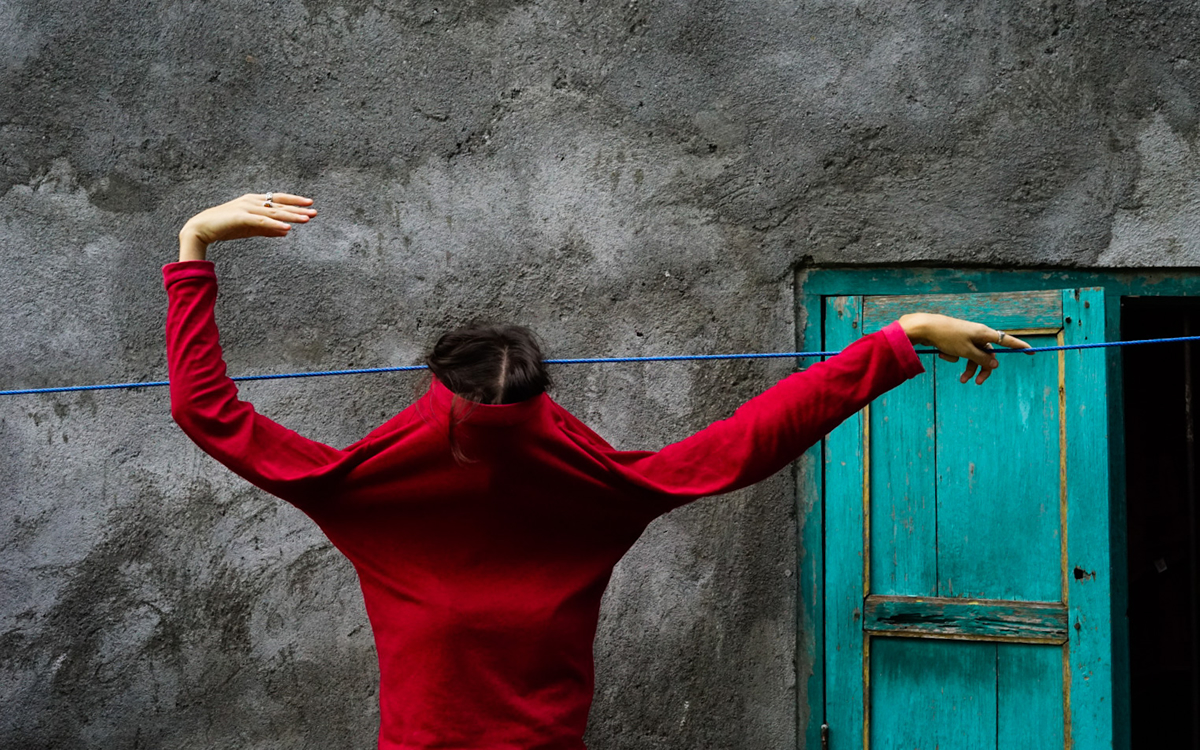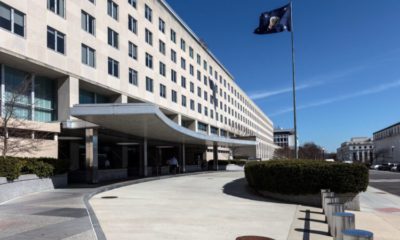Galleries
SPRING ARTS 2018 GALLERIES: Back to the ‘80s
Warhol imagery pops up at Hirshhorn exhibit on logos and products


‘Shrumen Lumen’ by FoldHaus in the ‘No Spectators: The Art of Burning Man’ exhibit at Renwick Gallery of the Smithsonian American Art Museum. (Courtesy of Renwick Gallery of the Smithsonian American Art Museum. Photo by Rene Smith)
Hirshhorn Museum and Sculpture Garden (Independence Ave., and 7th St., N.W.) presents “Brand New: Art and Commodity in the 1980s” on display through May 13. About 150 works explore the origin of how ‘80s artwork used defining moments such as the rise of MTV, gentrification and the AIDS crisis. The exhibit also explores how artists took consumer culture of advertising, logos and products to create a new form of art. Influential artists including Andy Warhol, Ashley Bickerton, Jessica Diamond, Peter Halley, Jeff Koons and many more will be displayed. For more details, visit hirshhorn.si.edu.
Artists & Makers Studios celebrates three years of having two locations with “at 3(three)” on tonight (March 2) from 6-9 p.m. Visitors can tour the three main galleries and open studios at Artists & Makers Studios 1 (11810 Parklawn Dr., Rockville, Md.). There will be food, drink and an open mic. At Artists & Makers Studios 2 (12276 Wilkins Ave., Rockville, Md.), residents’ artwork will be displayed as well as Montgomery County Camera Club with “Abstract Minimalism” by Ron Ames and exhibits in Gallery 209. The band Paradise Bill will perform. Arthur Harrison will also perform on the theremin. There will be wine and light refreshments served at this location. Exhibits will be on display through Wednesday, March 28. For more details, visit artistsandmakersstudios.com.
Touchstone Gallery (901 New York Ave., N.W.) showcases three new exhibits from March 2-April 1. “The Long and Short of It,” an exhibit by Touchstone artists focused on shape, will be in Gallery A. “She Runs Wild” by Makda Kibour, an abstract series on canvas based on Kibour’s emotions, will be in Gallery B. Gallery C will have “Marie Antoinette” by Meg Schaap, an examination of France’s legendary queen. There will be an opening reception on tonight (March 2) from 6-8:30 p.m. A Meet the Artist discussion will be held on Sunday, March 25 from 1-3 p.m. For more information, visit touchstonegallery.com.
National Museum of Women in the Arts (1250 New York Ave., N.W.) presents “Women House” from March 9-May 28. This exhibit is a sequel to the 1972 exhibit “Womanhouse” by Judy Chicago and Miriam Schapiro which explored the woman’s place in the home. In the new exhibit, artists challenge the convention of women in the home with photographs, videos, sculptures and room-like installations. Admission is $10 for adults, $8 for students and visitors 64 and under. Children under 18 are free. For more details, visit nnwa.org.
Hillwood Estate, Museum & Gardens (4155 Linnean Ave., N.W.) hosts the Fabergé Egg Festival on Saturday, March 24 from 10 a.m.-5 p.m. Majorie Post’s imperial eggs and other Fabergé creations in Post’s collection will be on display. Samovar Russian Folk Music Ensemble will perform folk music and Kalinka Dance Ensemble will accompany with a performance. The Happenstance Theater will present a family play telling stories from Russian Easter traditions. There will be a traditional Russian egg rolling game and a Fabergé workshop for visitors to decorate their own eggs. Tickets range from $5-18. For more details, visit hillwoodmuseum.org.
Renwick Gallery of the Smithsonian American Art Museum (1661 Pennsylvania Ave., N.W.) displays “No Spectators: The Art of Burning Man” from March 30- Jan. 21, 2019. The large-scale exhibit will take over the entire museum. The phenomenon of the festival Burning Man will be traced in room-sized installations, costumes, jewelry, photographs and other archival material. There will be an opening party on Thursday, March 29 from 7:30 p.m.-midnight. Tickets are $120 and include entry to the exhibit, food, open bar and more. For more information, visit americanart.si.edu.

New England artists Caroline Rufo and John Rufo, also known as RufoArt will open an exhibition on Thursday, Aug. 10 at 6 p.m. at Nepenthe Gallery.
The husband-and-wife duo will share their paintings and also talk about their inspirations. Caroline explores the natural beauty, ideas, and systems of power that create her surroundings while John works toward an understanding of art as a representation of singular moments of both immediate presence and a larger context of wholeness.
For more details, visit Nepenthe Gallery’s website.
Galleries
John Waters introduces the world to his ‘roommates’
Baltimore Museum of Art showcases filmmaker’s eclectic collection in new exhibit

As open as he is about his childhood and his movies and the causes he supports, writer and filmmaker John Waters remains guarded about his personal life.
From Waters’ books, interviews and speaking engagements, fans know that he’s gay and who his longtime friends are. They know he has three residences — in Baltimore, New York, and San Francisco — and that he spends his summers in Provincetown. They know where he plans to be buried, and with whom. But Waters reveals little about his most intimate relationships.
“I have to talk about my movies. I have to give interviews to promote what I’m doing,” he once said. “But no one really knows my personal life. And if you don’t have a personal life, I feel bad for you.”
So it was a bit surprising this fall to hear Waters talk about the “roommates” he lives with, as if he’s a college kid in the freshman dorm, or he’s renting out rooms to cope with inflation.
During a press briefing about a new exhibit at the Baltimore Museum of Art, Waters volunteered that he has roommates in each of his three residences. In many cases, he said, he’s had these roommates for years. And they’re not members of his biological family; he chose to live with them.
But for those hungry for morsels about Waters’ private affairs, these aren’t exactly romantic roommates. The museum event was a preview for “Coming Attractions: The John Waters Collection,” an exhibition of 83 works of contemporary art from Waters’ personal collection, that runs until April 16, 2023. And ‘roommates,’ Waters explained at the briefing and in a “go mobile’ narration that accompanies the show, is the term he uses to refer to the works of art at his different homes.
“My roommates — that’s what I’ve always called my art collection,” he said at the media event.
“I call art my roommates because I live with them,” he explains in the taped narration. “I look at them every day…We live in a commune.”
Waters’ notion of art works as roommates is not new. He wrote about it in a chapter of his 2010 book, “Role Models,” in which he describes the art in his homes as roommates, having traits that he likes and seeks out for all of his homes. He said he prefers the companionship of art-roommates to live ones.
“No sirree, no real-life people sharing my bathroom or reading my newspapers before me!” he vowed. “Instead, I live with artists. Mike Kelley is one of my roommates.”
Visitors to Waters’ homes, including guests at his annual Christmas party in Baltimore, have been lucky enough to see what he’s talking about. The BMA exhibit is the first time he’s shared his companions on such a large scale.
Part of the fun of the exhibit for him, Waters said during a walk-through of the show, has been seeing his roommates from his three different residences, in the same space for the first time, in some cases side-by-side.
“They’ve never met each other before,” he said. “It was like [the curators] were introducing different artists that should have met a long time ago.”
Though he’s perhaps best known for films such as “Hairspray” and “Pink Flamingos,” bestsellers such as “Role Models” and “Carsick,” and nicknames such as “The Pope of Trash” and “The Prince of Puke,” Waters, 76, is also a visual artist and noted art collector.
He was the subject of a retrospective entitled “John Waters: Indecent Exposure” at the BMA and the Wexner Center for the Arts in Columbus, Ohio, in 2018 and 2019. He has two works on view in the inaugural show at the Rubell Museum that recently opened in Washington, D.C., “Beverly Hills John” and “Shoulda!”
The 83 works on view in “Coming Attractions” were culled from a larger group of about 375 works that Waters, a Baltimore native and BMA trustee, has agreed to leave to the museum when he dies.
Waters’ gift to the BMA includes 288 works by 125 artists other than himself, in a variety of art forms. Waters also donated 87 prints, sculptures, mixed-media and video pieces that he created. His gift will make the BMA the greatest single repository of his visual artwork and will enable it to provide, in perpetuity, a comprehensive view of his vision and approach to making and collecting art.
When Waters’ gift was announced in 2020, directors promised the museum would have a preview of what’s to come while he was still alive, and this is it. All of the works in the show are on loan from Waters and will go back to him when the show is over.
In return for his gift, the museum board said it would name restrooms and a rotunda after him. That wasn’t a putdown. Known for his raunchy humor and offbeat way of thinking, Waters specifically asked to have his name on the restrooms, the first at the BMA that are “all gender.”
Christened last fall with a “first pee” by trans artist and activist Elizabeth Coffey, The John Waters Restrooms are right next to The Nancy Dorman and Stanley Mazaroff Center for the Study of Prints, Drawings and Photographs, where “Coming Attractions” opened on Nov. 20. The museum has also agreed to display prominently five works from the collection, including one by Waters, at all times.
“Coming Attractions” is one of two Waters-related museum exhibits opening over the next year, along with “Pope of Trash,” a career retrospective at the Academy Museum of Motion Pictures in Los Angeles in 2023. Dates for the retrospective have not been announced.
Unlike “Indecent Exposure” three years ago, “Coming Attractions” doesn’t include works by Waters. Instead, it provides an insider’s look at his tastes in contemporary art, and how he lives with art, by focusing on works by others that he has collected and displayed at his homes in Baltimore, New York, and San Francisco.
The guest curators are photographer Catherine Opie and multi-media artist Jack Pierson, both of whom have been friends with Waters for years and are represented in his collection. Both identify as queer, as do many of the artists represented in the exhibit. The show is organized by Leila Grothe, the museum’s Associate Curator of Contemporary Art.
Among the featured works are paintings, sculptures, photographs, and prints by Diane Arbus; Nan Goldin; Mike Kelley; Cindy Sherman; Cy Twombly; Andy Warhol; Christopher Wool, Gary Simmons and others.
The museum refers to the exhibit as “a cutting-edge articulation of American individualism, particularly as it relates to queer identity and freedom of expression.”
“All of John has been a go-to for me, as a young queer,” said Opie, who has a portrait of Waters in the show. The works “represent a type of contemporary art that the museum actually just doesn’t really have,” Grothe said.
Waters’ collection is a reflection of his personality and imagination, Opie and Pierson said in a joint statement.
“Our hope is to share with audiences another aspect of John’s creative vision by offering a glimpse into what he values: artists who are unafraid to take risks, who do not compromise, and who create their art on the margins.”
The roommate reference could have been a one-liner, but Waters takes the idea and runs with it, building on what he wrote in his Roommates chapter in “Role Models.”
“They delighted me or made me angry or made me laugh or I thought did something in a new way,” he said of his companions. “They just challenged me and I wanted to live with them because art’s your roommates. You live with them forever.”
In talking about his ‘roommates,’ Waters makes it seem as if they are sentient beings who have minds, feelings and personalities of their own, and who can interact with each other, perhaps when the museum is closed.
He paints a picture of his roommates being the art world equivalent of the robotic “hosts” in HBO’s “Westworld,” or the exhibits from “Night at the Museum” and its sequels, movies in which works of art come to life.
Waters talks about his roommates hanging out together, knowing they’re in the home of the Cone Collection with its priceless paintings by Henri Matisse and other masters. He thinks about how they’re adjusting to their temporary home. He muses about them developing relationships they couldn’t have in the different residences and becoming friends. He imagines his roommates plotting with each other. He fantasizes about them sneaking out of the gallery they’re in and exploring other parts of the museum.
Asked at a donors’ event how he thinks his roommates are getting along in their new setting, Waters didn’t miss a beat: “I think they’re so happy to meet each other,” he said. “And they all want to gang up and scare The Blue Nude.”
It’s not that much of a stretch to think in those terms, since many of the works in Waters’ collection are images either of his friends (the late Cookie Mueller), or by his friends (Vincent Peranio), or both (Susan Lowe’s drawing of Mink Stole.)
The curators are going along with it, too, talking about ‘introducing’ different works so they can be “in conversation’ with each other.
“John delights in the fact that these works, all pulled from different homes, are meeting each other for the first time,” Grothe said at the press preview, pointing to a wall with works from three different residences.
“How great does this wall look with Richard Tuttle on the left, the sculpture by Vincent Fecteau in the center, and Gary Simmons on the right?” she asked. “There’s a lot to say about each artwork, but for now we should just appreciate the budding of a new friendship between these pieces.”
The curators positioned certain works to show how they “begin to speak to one another in different ways,” Opie said. “Throughout the exhibition, you’ll notice these little groupings…that we ended up putting together so that they could have a conversation.”
Was anyone left out of the party?
Pierson said he regrets that there isn’t an “Edith Massey moment” in the show, in honor of the character who played Edith the Egg Lady in “Pink Flamingos,” so her voice could be part of the mix. “I’m sure I could have found one,” he said.
“The only piece that would remind me of her [is one] that I didn’t buy but I wish I did, by George Stoll,” Waters said. “He made fake Easter eggs, but the collector hides them in their house so no one ever sees them. And you forget them, yourself, that you have them. And then you’re going through an old drawer – Oh! There’s a piece of art I bought!”
During the donors’ event, Grothe asked Waters what his homes feel like with much of the art out on loan. She said people at the museum are worried about him, living without his roommates. Waters said his homes look and feel empty.
“It looks like I’m moving, everywhere, because they didn’t take everything,” he said. “So there are big holes in the wall, and dirt.”
Waters said he keeps thinking Louise Lawler should come over, a reference to the artist who’s made a career of studying and documenting art installations. “It’s a great installation for her to do.”
Waters went even further in the taped narration, likening his residences to scenes of a crime, still in disarray.
“They have come to all my homes and taken half the stuff off the walls,” he laments. “So now I live in abandoned squats that look like art robberies happened in my house.”
At the same time, he admits, his roommates look good in their museum setting.
“You can see them so much better,” he said. “I don’t have good lighting. They cleaned them, too. They were dirty, some of them.”
Even though the show just opened, Waters is already thinking about what happens after it comes down.
“It’s weird,” he said. “It’s going to be hard to put them back where they went after seeing them in here together.”
Waters said he thought about putting his roommates back differently, taking cues from the exhibit and preserving some of the new ‘relationships’ formed at the museum. He said he‘s grateful to the curators for coming up with “a whole new way” to show them off.
“Maybe I’m going to never be able to hang it back the way it was [and] have to put it back the way you did it,” he told the curators at one point.
But ultimately, he said, he decided against shifting everything around.
“Oh god, that would really be complicated,” he said. “I’d have to move all the furniture and change everything. So they will go back, lonely.”
Waters said he knows that won’t be as much fun for his roommates, not hanging with their new friends. But he notes this isn’t the last time they’ll see each other, since they’ll be returning to the museum eventually.
After all, he said, “they know that way later, after I’m dead, they’ll get together again.”
Galleries
Artists examine gender identity in D.C. exhibition
Event sponsored by the Blade, Dupont Underground

Each weekend this June, visitors to Dupont Underground — an arts space built into an abandoned trolley station under Dupont Circle — will find walls lined with artwork ranging from embroidery to watercolors. Together, the pieces make up the Underground’s latest exhibition, “The Gender Within: The Art of Identity,” which unites more than 35 local artists in a conversation on gender identity and the dynamic ways that gendered labels are experienced.
Sianna Joslin, a web developer by day and one of the artists participating in the exhibition, is including a piece entitled “The Inherent Agony of Having A Body” — an embroidery hoop that depicts an anatomical model of a transmasculine individual bearing top surgery scars and patterned red boxers.
The piece juxtaposes “the old ideals of the human body, the male form, with top surgery scars (and) these funny pennant boxers,” they said. “It’s kind of a play on what society has traditionally considered masculine versus these new symbols of masculinity that transmasculine folks are embracing.”
Another artist, Rashad Ali Muhammad, brings to the exhibition a compilation of videos in which colorful, moving backgrounds are transplanted onto the faces of different people — pieces that originally began as NFTs.
This project, entitled “A World Within,” was inspired by the realities of existing in a period of social volatility like the pandemic, and aims to show the “worlds” that exist within each person, Ali Muhammad said.
Left to face the challenges of the pandemic and broader social inequities, “you need to take the time inwardly to think about and process everything that’s going on,” they explained. “You have to go within to understand who you are sometimes.”
Nikki Brooks, whose painting “Blaq Jesus” portrays a Black and androgynous Jesus smoking a cigarette with a nondescript expression, rooted her creative exploration in her experience with societal gender norms.
“For a long time I struggled with my gender expression. I had to live up to how people framed me … putting this femininity on me,” she said. The painting challenges “pressures from people saying that one person has to be one way, or express themselves one way,” and encourages others to “let them live how they feel on the inside.”
Brooks also noted the use of religious imagery was key to her piece. In historical depictions of Jesus, he is often assigned certain racial and gender identity markers according to societal demands, she said. “This Black Jesus in a way defies all those stigmas” tied to the identities depicted by connecting them to a revered religious icon.
The artists all noted that they are excited by the diversity of experiences the Underground’s exhibition has brought together.
“We’re going to see — from all of these different artists — interpretations of what gender means to them, and I just think that’s wonderful,” Joslin said. “I really hope that it expands on that notion of gender for a lot of people.”
Ali Muhammad found the exhibition especially meaningful for openly creating space for queer artists.
“In the history of art, a lot of artists tend to be queer … but people don’t talk about that,” they said. “Focusing specifically on queer art and queer artists (says) we are here, we are represented.”
The exhibition, cosponsored by the Washington Blade and Dupont Underground, can be accessed at 19 Dupont Circle, N.W., each Friday, Saturday and Sunday in June from 11 a.m. to 5 p.m. Entry costs $10 per person, or $7 for students, seniors and members of the military.
-

 State Department4 days ago
State Department4 days agoState Department releases annual human rights report
-

 South America2 days ago
South America2 days agoArgentina government dismisses transgender public sector employees
-

 District of Columbia2 days ago
District of Columbia2 days agoCatching up with the asexuals and aromantics of D.C.
-

 Politics4 days ago
Politics4 days agoSmithsonian staff concerned about future of LGBTQ programming amid GOP scrutiny












